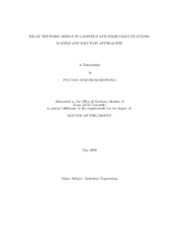| dc.description.abstract | Strategic network design has significant impacts on the operational performance
of transportation and telecommunications industries. The corresponding networks
are typically characterized by a multicommodity
ow structure where a commodity
is defined by a unique origin-destination pair and an associated amount of
ow. In
turn, multicommodity network design and hub location models are commonly employed
when designing strategic networks in transportation and telecommunications
applications.
In this dissertation, these two modeling approaches are integrated and generalized
to address important requirements in network design for truckload transportation and
long-distance telecommunications networks. To this end, we first introduce a cost effective relay network design model and then extend this base model to address the
specific characteristics of these applications. The base model determines relay point
(RP) locations where the commodities are relayed from their origins to destinations.
In doing this, we explicitly consider distance constraints for the RP-RP and nonRPRP
linkages.
In truckload transportation, a relay network (RP-network) can be utilized to
decrease drivers' driving distances and keep them within their domiciles. This can potentially help alleviate the high driver turnover problem. In this case, the percentage
circuitry, load-imbalance, and link-imbalance constraints are incorporated into
the base model to control related performance metrics that are affected by the distance
constraints. When compared to the networks from other modeling approaches,
the RP-network is more effective in controlling drivers' tour lengths and capable of
controlling the empty mileage to low levels without adding a large amount of additional
travel distance. In telecommunications, an RP-network can be beneficial in
long-distance data transfers where the signals' delity must be improved/regenerated
at RPs along their travel paths. For this setting, we extend the base model to include
fixed link setup costs and capacities. From our computational results, our models
provide better network configuration that is cost effective and facilitates a better
service quality (shorter delays and better connectivity).
Concerning methodology, we develop effcient exact solution algorithms based
on Benders decomposition, Lagrangean decomposition, and Lagrangean relaxation.
The performance of the typical solution frameworks are enhanced via numerous accelerating
techniques to allow the solution of large-sized instances in reduced solution
times. The accelerating techniques and solution approaches are transferable to other
network design problem settings with similar characteristics. | en |


